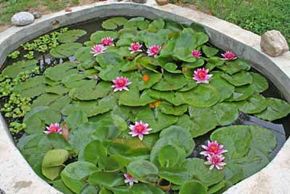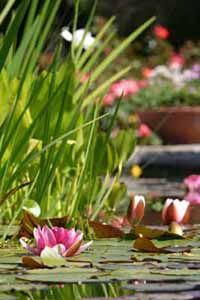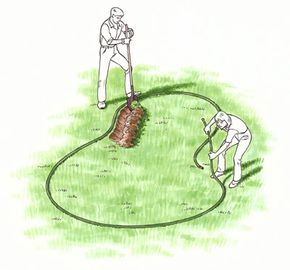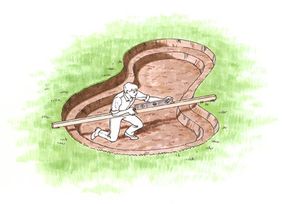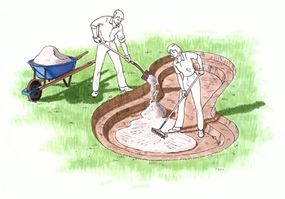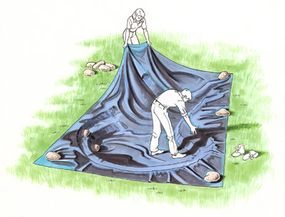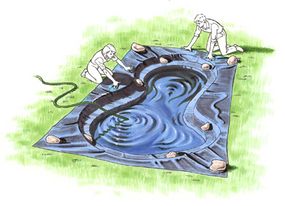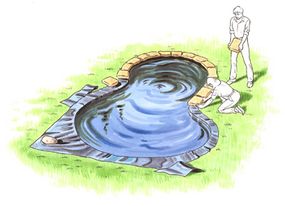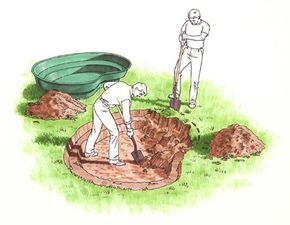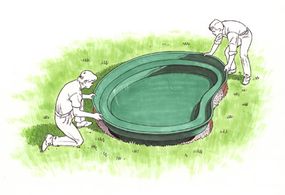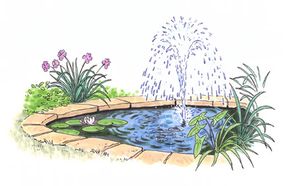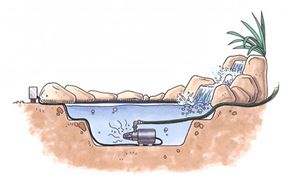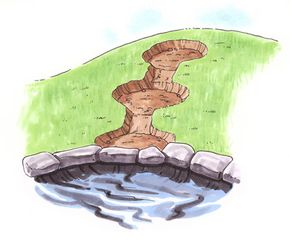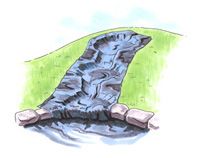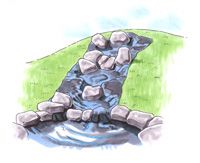Moving water is not required in a water garden -- aquatic plants, for example, grow best in still water -- but a waterfall or fountain adds several advantages. Moving water is better aerated than still water so fish do better. A filter can easily be added to any pump, making water clearer. But the main reason for including a pump in your water garden is aesthetic: People enjoy the sound and sight of moving water.
Care should be taken to avoid creating strong currents or excessive splashing near aquatic plants or they can be damaged. Fountains especially are not conducive to plant life, as their spray can reach considerable distances under strong winds. Waterfalls can usually be separated from water lilies and other plants by placing the cascade at one end of the pool and installing a few well-placed rocks to diffuse the current.
Choose the form of moving water that best corresponds to your pool. Fountains and other pool ornaments are best for formal pools. Waterfalls cascading over rocks work well for irregular pools in a more natural setting. And simple underwater filter systems suit any kind of pool.
There is no lack of choices among fountains: cones, sprays, jets, bubble effects, or pretty much whatever you want. Pipe heads can also be fitted to ornamental statues, ceramic jars, or bamboo pipes. When installing a fountain, make sure the height of the spray is not more than half the diameter of the pond; otherwise much of the water will end up being sprayed out of the pool during windy periods.
If your yard has a natural slope, consider installing a waterfall: It will help integrate your water garden into the rest of the landscape. Waterfalls can also be used in flat areas, but care should be taken that the resulting raised section doesn't stick out like a sore thumb. Place tall plants or a fence behind the waterfall to ease this potential problem. The combination of rock gardens and waterfalls is a natural one since the waterfall is set off by rocks anyway and rock garden plants, generally low-growing, won't block the view of the resulting stream.
Prefabricated waterfall units are readily available and easily installed. They may consist of an entirely preformed section with several tiers, or they may be individual catch basins designed to be placed so that each one slightly overhangs the previous one. It is also easy to make your own waterfall using a section or sections of flexible liner.
There is a wide variety of pumps available for water gardens. The pump should be chosen according to the quantity of water to be moved, the distance the water has to cover, and the height the water is to be pushed. For example, it requires much more power to pump a fast-moving stream of water five feet up and ten feet from the pool for an extensive waterfall than to simply filter the water in a pond. Pumps generally come with charts detailing their capacity. Ask the supplier to help you choose if you have any doubts.
Always select a pump somewhat stronger than your needs, just in case. The pump should never have a rate of flow per hour greater than the capacity of the pond, but it should be able to circulate nearly half the pool's water per hour. To calculate the approximate volume of your pool, multiply its length by its width by its depth (in inches). This gives the number of cubic inches. Divide this by 231 to obtain the number of gallons. For example, a pool 10 feet (120 inches) by 6 feet (72 inches) by 18 inches deep would have a volume of 155,520 cubic inches, or 673 gallons. A pump rated at 300 gallons per hour would be adequate.
Water filters are not necessary for a healthy pond, but they do help keep the water clear and the pool free of debris. Mechanical filters are still the most popular and need only regular cleaning or replacement of the filter. Biological filters take up more space but need little upkeep.
Keep reading to learn how to choose a pump for a waterfall.
Looking for more information about water gardens? Try these:
